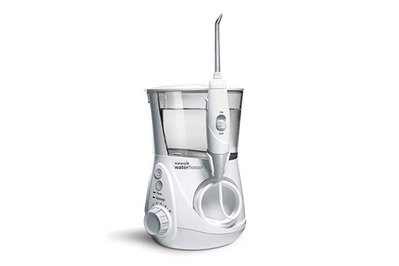
By Elissa Sanci
Elissa Sanci is a senior staff writer. She has found that clear ice makes carbonated drinks taste better, and citronella candles don’t work.
Water flossers—electronic machines that shoot a thin stream of water to clean between your teeth—are a great alternative to traditional string floss. Not only can they help you cut back on plastic waste, but they’re also easier to maneuver around your mouth than a piece of string. And depending on the model, they can even work in the shower.
But keeping a water flosser clean requires some diligence. Amy Lemons, a registered dental hygienist, says it should be deep-cleaned every one to three months—unless you notice any signs of mold, biofilm, or mineral deposits from hard water, in which case she says you should clean it right away.
“One easy way to prevent [mold growth] from happening is to make sure the water reservoir is completely empty after use,” she says. “Dry any remaining water out with a towel if your model of water flosser allows you to easily remove the reservoir.”
Thankfully, deep-cleaning a water flosser is blissfully easy. We asked Lemons for advice on how to get your device squeaky clean.
Top pick
This powerful cleaner with 10 pressure settings delivers that “just left the dentist” feeling. But it’s larger than some other models, and it requires an outlet and a good deal of counter space.
How to deep-clean a water flosser
To effectively clean a water flosser, you don’t need much—just warm water, white vinegar, dish soap, a mild nonabrasive cleaner for the exterior of the device such as Clorox Free & Clear Multi-Surface Spray Cleaner, a drinking glass, and a microfiber cloth.
First, disassemble your flosser by removing the water reservoir and flossing wand from the unit. If you’re using a countertop water flosser, remove the valve from the reservoir, too. Wipe down the exterior of the machine with a damp cloth and a nonabrasive cleaner, and then set it aside.
Clean the water flosser’s plastic reservoir in the dishwasher or by hand. If you’re using the dishwasher, Lemons recommends placing it on the top rack and then removing it before the dishwasher’s heated dry cycle begins and allowing it to air dry. Hand-wash the reservoir valve with dish soap, rinse it by running it under warm water for 30 to 45 seconds, and then let it air dry.
While the reservoir dries, remove the flosser tip from the wand and set it aside. Combine two parts warm water with one part white vinegar in a pint glass or a tall drinking glass, and then place the wand upside down (to keep the cord from getting wet) in the mixture to soak for five to seven minutes. You can also soak the flosser tip in the same water-and-vinegar mixture, though Lemons recommends replacing your water flosser tip every three to six months since they can become clogged by mineral deposits.
To clean the internal parts of the water flosser, first reassemble the machine. Fill the water reservoir with 1 or 2 tablespoons of vinegar and 16 ounces of warm water, and then run the solution through the flosser until the reservoir is empty. (Make sure to direct the stream of water into the sink!) Afterward, fill the tank with clean water and run the flosser again to flush the vinegar from the machine.
Once your machine is free of gunk, it can go back to doing its job: getting the gunk out of your teeth.
This article was edited by Megan Beauchamp and Catherine Kast.
Meet your guide
I cover a little of everything, from travel gadgets and car-organizing tools to label makers and reusable tumblers. I have an affinity for testing the buzzy products you’ve probably seen clogging your social media feeds—my goal is to figure out which trending items are actually worth your time, and which are a waste of money.
Mentioned above
- We’ve tested 12 water flossers okayed by the American Dental Association. The sturdy Waterpik Ion is the one we’d get.The Best Water Flossers
- Cocofloss is a plush, gentle, and effective string floss that comes in a reliable, refillable package.Cocofloss Is a Delicious Way to Clean Teeth and Toss (A Little) Less Plastic
- Biokleen Spray & Wipe All-Purpose Cleaner rids surfaces of grime and comes with the EPA’s Safer Choice certification.The Best Surface Cleaners and Disinfectants
- Most microfiber cloths are essentially the same, but after weeks of testing, our cleaning writer liked Fixsmith Microfiber Cleaning Cloths best.The Best Microfiber Cleaning Cloths
Further reading
This Cleaning Powder Was Invented in the 1880s. It Still Keeps My Kitchen Gear Looking New.
by Christine Cyr Clisset
Bar Keepers Friend is my go-to tool for deep-cleaning the stainless steel surfaces and pans in my kitchen.
The Best Bathroom Rugs and Bath Mats
by Dorie Chevlen
A good bath mat can keep you from slipping and add pizzazz to your bathroom. These seven durable, comfortable options will work for a variety of styles.
The Best Electric Toothbrush for Kids
by Nancy Redd
Kids don’t need an electric toothbrush to achieve good dental hygiene, though a smaller brush head and a built-in timer may help them brush better.
Ask Wirecutter: How Can I Get My Partner to Stop Leaving Hair Everywhere?
by Annemarie Conte
Easy cleanup tips for hair that’s all over the bathroom.






